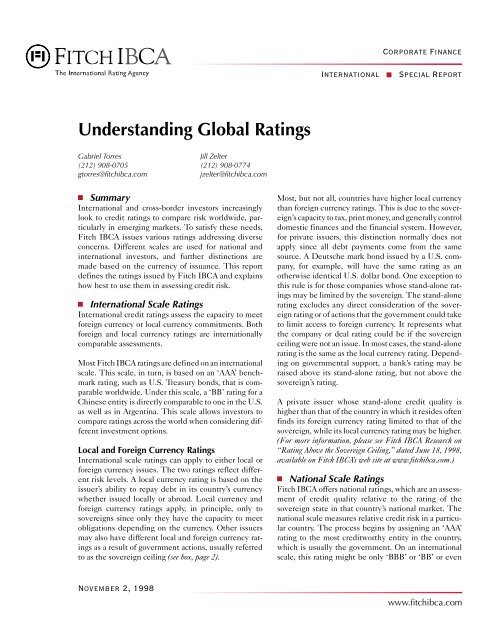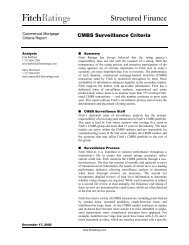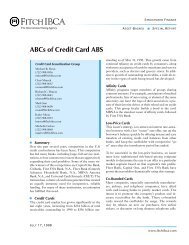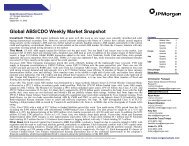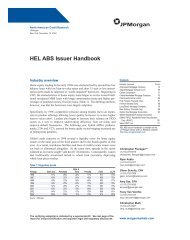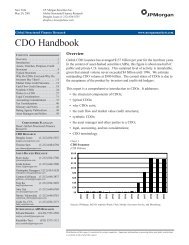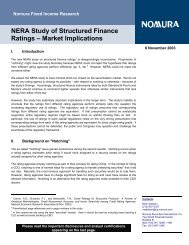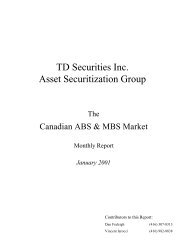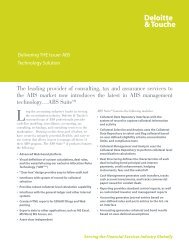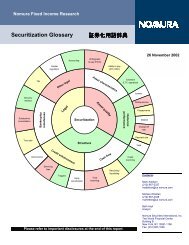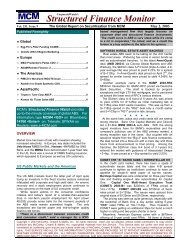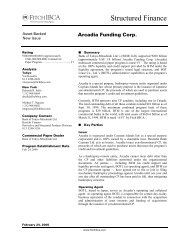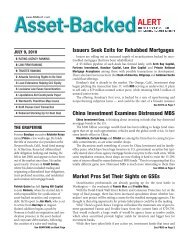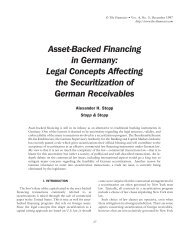Understanding Global Ratings - Securitization.Net
Understanding Global Ratings - Securitization.Net
Understanding Global Ratings - Securitization.Net
Create successful ePaper yourself
Turn your PDF publications into a flip-book with our unique Google optimized e-Paper software.
Corporate Finance<br />
International<br />
Special Report<br />
<strong>Understanding</strong> <strong>Global</strong> <strong>Ratings</strong><br />
Gabriel Torres<br />
Jill Zelter<br />
(212) 908-0705 (212) 908-0774<br />
gtorres@fitchibca.com<br />
jzelter@fitchibca.com<br />
Summary<br />
International and cross-border investors increasingly<br />
look to credit ratings to compare risk worldwide, particularly<br />
in emerging markets. To satisfy these needs,<br />
Fitch IBCA issues various ratings addressing diverse<br />
concerns. Different scales are used for national and<br />
international investors, and further distinctions are<br />
made based on the currency of issuance. This report<br />
defines the ratings issued by Fitch IBCA and explains<br />
how best to use them in assessing credit risk.<br />
International Scale <strong>Ratings</strong><br />
International credit ratings assess the capacity to meet<br />
foreign currency or local currency commitments. Both<br />
foreign and local currency ratings are internationally<br />
comparable assessments.<br />
Most Fitch IBCA ratings are defined on an international<br />
scale. This scale, in turn, is based on an ‘AAA’ benchmark<br />
rating, such as U.S. Treasury bonds, that is comparable<br />
worldwide. Under this scale, a ‘BB’ rating for a<br />
Chinese entity is directly comparable to one in the U.S.<br />
as well as in Argentina. This scale allows investors to<br />
compare ratings across the world when considering different<br />
investment options.<br />
Local and Foreign Currency <strong>Ratings</strong><br />
International scale ratings can apply to either local or<br />
foreign currency issues. The two ratings reflect different<br />
risk levels. A local currency rating is based on the<br />
issuer’s ability to repay debt in its country’s currency<br />
whether issued locally or abroad. Local currency and<br />
foreign currency ratings apply, in principle, only to<br />
sovereigns since only they have the capacity to meet<br />
obligations depending on the currency. Other issuers<br />
may also have different local and foreign currency ratings<br />
as a result of government actions, usually referred<br />
to as the sovereign ceiling (see box, page 2).<br />
Most, but not all, countries have higher local currency<br />
than foreign currency ratings. This is due to the sovereign’s<br />
capacity to tax, print money, and generally control<br />
domestic finances and the financial system. However,<br />
for private issuers, this distinction normally does not<br />
apply since all debt payments come from the same<br />
source. A Deutsche mark bond issued by a U.S. company,<br />
for example, will have the same rating as an<br />
otherwise identical U.S. dollar bond. One exception to<br />
this rule is for those companies whose stand-alone ratings<br />
may be limited by the sovereign. The stand-alone<br />
rating excludes any direct consideration of the sovereign<br />
rating or of actions that the government could take<br />
to limit access to foreign currency. It represents what<br />
the company or deal rating could be if the sovereign<br />
ceiling were not an issue. In most cases, the stand-alone<br />
rating is the same as the local currency rating. Depending<br />
on governmental support, a bank’s rating may be<br />
raised above its stand-alone rating, but not above the<br />
sovereign’s rating.<br />
A private issuer whose stand-alone credit quality is<br />
higher than that of the country in which it resides often<br />
finds its foreign currency rating limited to that of the<br />
sovereign, while its local currency rating may be higher.<br />
(For more information, please see Fitch IBCA Research on<br />
“Rating Above the Sovereign Ceiling,” dated June 18, 1998,<br />
available on Fitch IBCA’s web site at www.fitchibca.com.)<br />
National Scale <strong>Ratings</strong><br />
Fitch IBCA offers national ratings, which are an assessment<br />
of credit quality relative to the rating of the<br />
sovereign state in that country’s national market. The<br />
national scale measures relative credit risk in a particular<br />
country. The process begins by assigning an ‘AAA’<br />
rating to the most creditworthy entity in the country,<br />
which is usually the government. On an international<br />
scale, this rating might be only ‘BBB’ or ‘BB’ or even<br />
November 2, 1998<br />
www.fitchibca.com
<strong>Understanding</strong> <strong>Global</strong> <strong>Ratings</strong><br />
Sovereign Ceiling<br />
A sovereign’s rating on its foreign currency obligations has traditionally<br />
been regarded as the ceiling on ratings for other issuers domiciled in the<br />
country. The assumption is that a sovereign default will force all domestic<br />
issuers to default. Circumstances leading to a national debt crisis, which<br />
include economic and political upheavals, balance of payments crises,<br />
trade shocks, and high inflation, directly affect the debt servicing capacity<br />
of private lenders. More important, countries facing default may impose<br />
exchange controls and other restrictive measures that impede access by<br />
issuers to the foreign currency necessary to service their obligations.<br />
The sovereign’s local currency rating, on the other hand, is usually not a<br />
ceiling on other ratings due to the government’s limited interest in<br />
restricting access to its own currency. Foreign currency is a very valuable<br />
commodity in a default crisis as opposed to local currency, the value of<br />
which is usually ravaged by high inflation in those circumstances. But<br />
sovereign foreign ratings do not always act as a ceiling. Fitch IBCA has<br />
rated issuers (YPF S.A. and MetroGas S.A. in Argentina), transactions<br />
(PDVSA Ltd. Finance in Venezuela, Sino Commercial Properties Funding,<br />
Ltd. in Hong Kong), and project financing (Cerro Negro Finance,<br />
Ltd. and Fertilizantes Nitrogenados de Venezuela in Venezuela) higher<br />
than the respective country’s ratings.<br />
lower. While international credit ratings<br />
are comparable on a worldwide<br />
basis, national ratings refer only to issuers<br />
within their own country.<br />
Fitch IBCA Rating<br />
Methodology<br />
YPF S.A., Argentina’s largest corporation,<br />
is one example of Fitch IBCA’s<br />
ratings approach. Currently, Fitch<br />
IBCA has three different ratings for this<br />
oil company. On the international scale,<br />
YPF is rated ‘BBB–’ for foreign currency<br />
and ‘A–’ for local currency. Both<br />
ratings are higher than Argentina’s ‘BB’<br />
foreign currency and ‘BB+’ local currency<br />
ratings. YPF’s foreign currency<br />
rating, although not automatically limited<br />
to the government’s rating, is nevertheless<br />
constrained, which is why it is<br />
lower than the local currency rating.<br />
These ratings are comparable across<br />
the world. They reflect a higher capacity<br />
to pay peso rather than dollar debt<br />
due to the possibility of exchange controls<br />
limiting YPF’s access to foreign<br />
currency.<br />
On the national scale, YPF is rated<br />
‘AAA’, the highest possible rating.<br />
Fitch IBCA considers YPF one of the<br />
best credits within Argentina, and it is<br />
this scale that local investors look to<br />
when comparing opportunities within<br />
the country. The two scales complement<br />
each other and address different<br />
investor needs.<br />
Companies within the domestic market<br />
are assigned ratings based on their<br />
credit standing in relation to the benchmark<br />
and to other issuers in the country.<br />
This rating scale provides local and foreign<br />
investors with greater rating differentiation<br />
than does the international<br />
scale because the ratings assigned are<br />
not constrained by the sovereign ceiling.<br />
The ratings are modified with the<br />
addition of country-specific symbols to<br />
distinguish them from the international<br />
scale ratings.<br />
Rating Scales<br />
International Argentina Brazil Chile South Africa<br />
AAA AAA (arg) AAA (bra) AAA (chl) AAA (zaf)<br />
AA AA (arg) AA (bra) AA (chl) AA (zaf)<br />
A A (arg) A (bra) A (chl) A (zaf)<br />
BBB BBB (arg) BBB (bra) BBB (chl) BBB (zaf)<br />
BB BB (arg) BB (bra) BB (chl) BB (zaf)<br />
B B (arg) B (bra) B (chl) B (zaf)<br />
Note: Fitch IBCA has national scale ratings in four countries (Mexico will soon be added). All of<br />
them use the same letter system as in international ratings, with the addition of a country qualifier<br />
signaling that the rating is to be used only within the context of that country. All rating categories<br />
(except ‘AAA’ and categories below ‘CCC’) are further differentiated by the use of plus and minus<br />
signs.<br />
Copyright © 1998 by Fitch IBCA, Inc. • One State Street Plaza, NY, NY 10004 • Telephone: New York, 1-800-753-4824, (212) 908-0500, Fax (212) 480-4435; Chicago, IL, 1-800-483-4824, (312) 214-3434, Fax<br />
(312) 214-3110; London, 011 44 171 638 3800, Fax 011 44 171 374 0103; San Francisco, CA, 1-800-953-4824, (415) 732-5770, Fax (415) 732-5610 • Reproduction in whole or in part prohibited except by<br />
permission. Fitch IBCA ratings are based on information obtained from issuers, other obligors, underwriters, their experts, and other sources Fitch IBCA believes to be reliable. Fitch IBCA does not audit or verify<br />
the truth or accuracy of such information. <strong>Ratings</strong> may be changed, suspended, or withdrawn as a result of changes in, or the unavailability of, information or for other reasons. <strong>Ratings</strong> are not a recommendation<br />
to buy, sell, or hold any security. <strong>Ratings</strong> do not comment on the adequacy of market price, the suitability of any security for a particular investor, or the tax-exempt nature or taxability of payments made in respect<br />
to any security. Fitch IBCA receives fees from issuers, insurers, guarantors, other obligors, and underwriters for rating securities. Such fees generally vary from $1,000 to $750,000 per issue. In certain cases, Fitch<br />
IBCA will rate all or a number of issues issued by a particular issuer, or insured or guaranteed by a particular insurer or guarantor, for a single annual fee. Such fees are expected to vary from $10,000 to $1,500,000.<br />
The assignment, publication, or dissemination of a rating by Fitch IBCA shall not constitute a consent by Fitch IBCA to use its name as an expert in connection with any registration statement filed under the federal<br />
securities laws. Due to the relative efficiency of electronic publishing and distribution, Fitch IBCA Research may be available to electronic subscribers up to three days earlier than print subscribers.<br />
2 Fitch IBCA, Inc.


